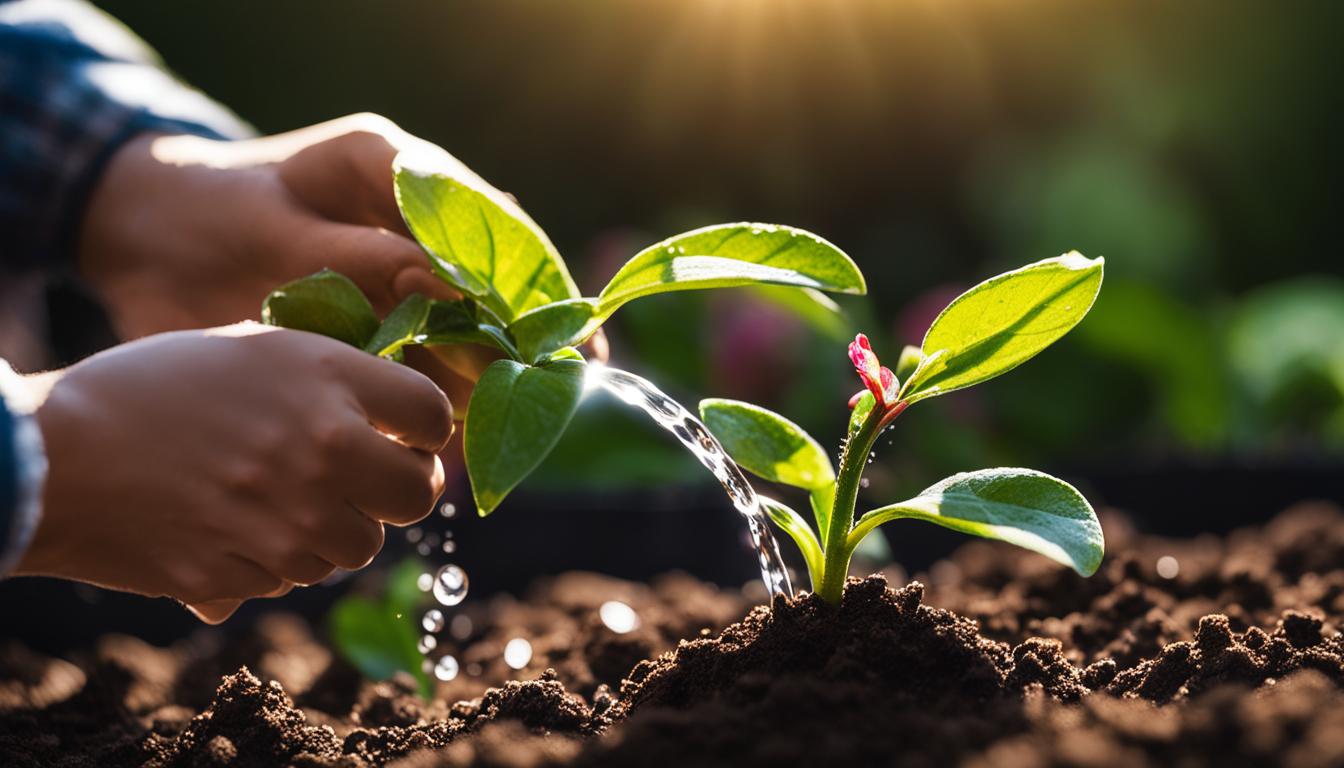Growing flowers brings immense joy to any gardener, whether you’re a seasoned pro or just starting out. There’s something magical about seeing those vibrant blooms brighten up your garden and bring a smile to your face. If you’ve always wanted to grow your own flowers but didn’t know where to start, you’ve come to the right place.
Welcome to “From Seed to Bloom: A Comprehensive Guide to Growing Flowers Successfully.” In this guide, I will walk you through everything you need to know about growing flowers and provide you with expert gardening tips and techniques. Whether you want to create a colorful flowerbed, cultivate a cutting garden, or simply add a touch of beauty to your outdoor space, this guide will be your trusted companion.
From choosing the right flower seeds to sowing, caring for, and troubleshooting common problems, this guide covers it all. With step-by-step instructions, insightful advice, and helpful illustrations, you’ll gain the confidence and knowledge to grow stunning flowers that will be the envy of your neighborhood.
Key Takeaways:
- Choose the right flower seeds for your gardening conditions.
- Consider starting seeds indoors or outdoors based on the flower’s requirements.
- Proper soil preparation is crucial for successful flower growth.
- Follow step-by-step instructions for sowing your flower seeds.
- Learn the best watering and care techniques to ensure healthy growth.
The Importance of Choosing the Right Seeds
The first step in growing flowers successfully is choosing the right seeds. Different flowers have different requirements, so it’s essential to select seeds that are suitable for your gardening conditions. Consider factors such as the size and habit of the flowers, as well as the time of year they will bloom.
When choosing flower seeds, it’s important to remember that not all seeds will thrive in every climate or soil type. Some flowers prefer full sun, while others thrive in partial shade. Additionally, certain flowers may require specific soil pH levels or drainage conditions. By selecting seeds that are well-suited to your garden’s unique characteristics, you can set yourself up for success.
The right flower seeds can make all the difference in creating a vibrant and beautiful garden. By choosing seeds that match your gardening preferences and conditions, you can ensure that your flowers will flourish and delight you with their color and fragrance.
“The seeds of today are the blossoms of tomorrow.” – Unknown
Tips for Selecting the Right Seeds
- Research the specific requirements of the flowers you are interested in growing. Consider factors such as sunlight, water, soil type, and temperature.
- Choose flower seeds that are appropriate for your location and climate. Some flowers are better suited to warm climates, while others thrive in cooler regions.
- Consider the size and habit of the flowers. Do you prefer tall, towering blooms or compact, bushy plants?
- Look for seeds that have a high germination rate and are known for their disease resistance.
- Consider the time of year the flowers will bloom. Do you want a garden that bursts with color in the spring or summer, or do you prefer flowers that bloom in the fall?
- Read reviews and recommendations from other gardeners to get insights into the quality and performance of different seed varieties.
By taking the time to select the right seeds for your flower garden, you are laying the foundation for success. With the right seeds and proper care, you’ll be rewarded with a vibrant and thriving garden that brings you joy throughout the seasons.
| Flower | Best Growing Conditions | Bloom Time |
|---|---|---|
| Rose | Full sun, well-drained soil | Spring through fall |
| Marigold | Full sun, average soil | Summer through fall |
| Petunia | Full sun to partial shade, well-drained soil | Spring through fall |
| Zinnia | Full sun, well-drained soil | Summer through fall |
Starting Seeds Indoors or Outdoors
Once you have your flower seeds, you have the option to start them either indoors or directly in your garden. This decision depends on various factors, such as the type of flower and your specific gardening conditions. Let’s explore the advantages of each method.
Starting Seeds Indoors
Starting flower seeds indoors allows you to have more control over the growing conditions and extend the growing season. By germinating seeds indoors, you can provide a stable environment with controlled temperature, light, and moisture levels. This method is particularly beneficial if you live in areas with shorter growing seasons or unpredictable weather.
When starting seeds indoors, you will need to gather the following materials:
- Seed starting trays or containers
- Seed starting soil
- Grow lights or a sunny windowsill
- Adequate water source
- Labels or markers for seed identification
Note: Refer to Table 1 in the guide for detailed instructions on starting seeds indoors.
Starting Seeds Outdoors
Some flower seeds, like zinnias, are easy to grow directly in the garden. These seeds can be sown outdoors, eliminating the need for indoor germination. This method is ideal if you have a suitable garden bed or container that meets the specific requirements of the flowers you are growing.
Before planting seeds outdoors, ensure the following conditions:
- Frost has subsided and the soil is warm enough for germination
- The selected garden bed or container is well-draining
- The area receives adequate sunlight according to the flowers’ needs
- The soil has been prepared and enriched with compost or organic matter
Note: Consult Table 1 in the guide for detailed instructions on starting seeds outdoors.
Table 1: Seed Starting Guide
| Step | Indoor Seed Starting | Outdoor Seed Starting |
|---|---|---|
| 1 | Prepare seed starting trays or containers filled with seed starting soil. | Ensure the garden bed or container is well-prepared and free from weeds. |
| 2 | Sow the seeds according to the recommended planting depth and spacing. | Sow the seeds directly into the soil, following the recommended planting depth and spacing. |
| 3 | Place the seeded trays or containers in a warm location with adequate light. | Water the seeded area gently, ensuring the soil remains consistently moist. |
| 4 | Water the seeds gently, ensuring the soil remains consistently moist. | Label the seeded area for easy identification. |
| 5 | Provide supplemental light using grow lights if natural light is inadequate. | Maintain the optimal growing conditions required by the specific flowers. |
| 6 | Monitor the seeds for germination and transplant seedlings if necessary. | Monitor the seeds for germination and provide additional care as needed. |
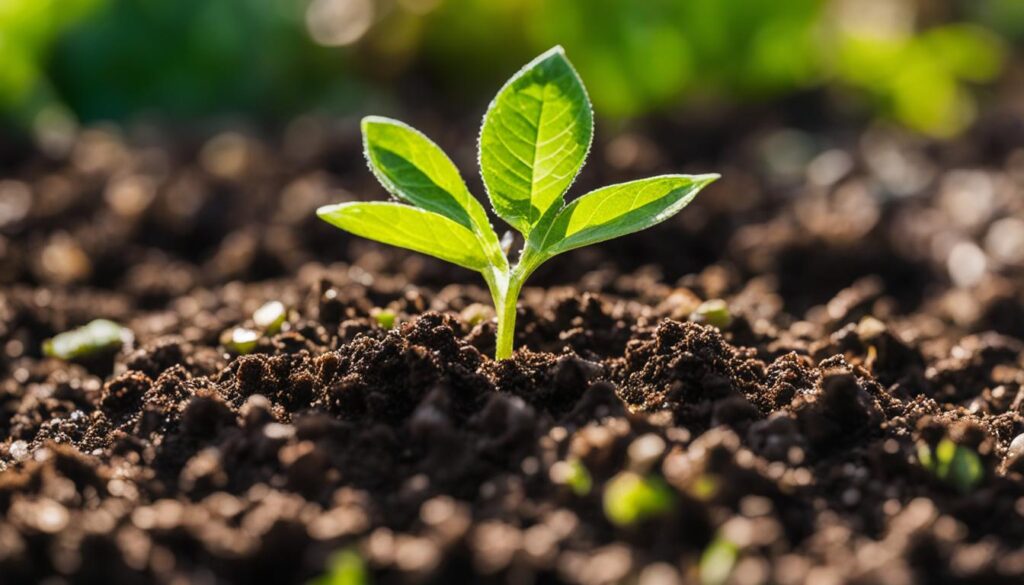
Proper Soil Preparation
To ensure the success of your flower seeds, it is crucial to properly prepare the soil. Choosing a high-quality seed starting soil is essential, as it provides a light and airy environment for the seeds to germinate and grow. The guide emphasizes the importance of using the right soil, and it offers valuable tips on soil selection and preparation to create the ideal conditions for your flower seeds to thrive.
Here are some key gardening techniques and tips for proper soil preparation:
1. Choosing the Right Seed Starting Soil
When selecting a seed starting soil, opt for a mix specifically formulated for seed germination. These mixes are usually lightweight, well-draining, and rich in nutrients—perfect for promoting healthy seedling growth.
2. Filling Your Containers
Whether you’re using seed trays, pots, or other containers, it is important to fill them with the appropriate seed starting soil. Start by gently moistening the soil to ensure it is evenly damp. Then, fill the containers, leaving a small gap at the top to allow for watering without overflow. Lightly press down on the soil to remove air pockets.
3. Optimal Soil Temperature
Consider the temperature requirements of your flower seeds. Most seeds germinate best at temperatures between 65°F and 75°F (18°C and 24°C). Use a soil thermometer to monitor the temperature and make any necessary adjustments to provide optimal conditions.
4. Adequate Drainage
Good drainage is crucial for healthy root development and preventing waterlogged soil, which can lead to root rot. Ensure that your containers have drainage holes to allow excess water to escape. If using trays, make sure they have drainage channels to prevent water from pooling around the containers.
5. Fertilizing Your Soil
Before planting your seeds, consider adding a slow-release fertilizer or organic compost to the soil to provide essential nutrients for growth. Follow the manufacturer’s instructions for the appropriate amount to use, as over-fertilization can harm the delicate roots of seedlings.
By following these gardening tips and techniques for proper soil preparation, you’ll create an optimal environment for your flower seeds to flourish. Remember, healthy soil sets the foundation for healthy plants!
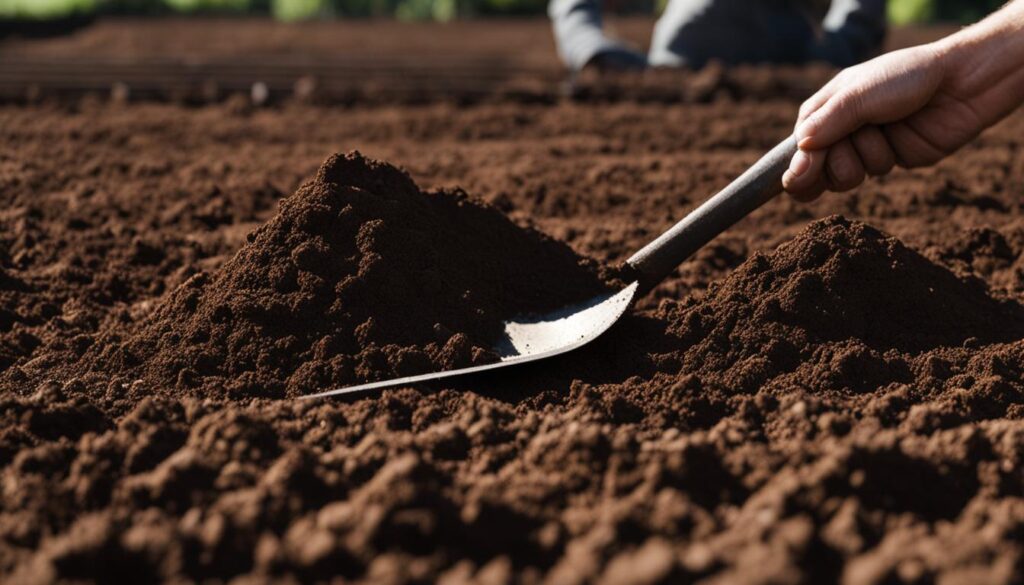
Sowing Your Seeds
Now that your soil is prepared, it’s time to sow your flower seeds and watch your garden come to life. Follow these step-by-step instructions to ensure successful seed sowing:
- Choose a sunny spot in your garden or prepare your seed trays indoors.
- Gently press your finger or a small tool into the soil, creating holes that are approximately twice the depth of the seed.
- Place the seeds into the holes, following the recommended number of seeds per cell or container. This information can usually be found on the seed packet or in the gardening guide.
- Cover the seeds with soil, lightly pressing it down to ensure good seed-to-soil contact.
- Water the area gently, using a fine mist or a watering can with a fine rose attachment. Avoid overwatering, as this can wash away the seeds.
- Label your seeds with the variety and date of sowing to keep track of your growing process.
Remember to be patient as your seeds germinate and grow. Provide them with the right conditions and care, and soon you’ll be rewarded with beautiful blooms.
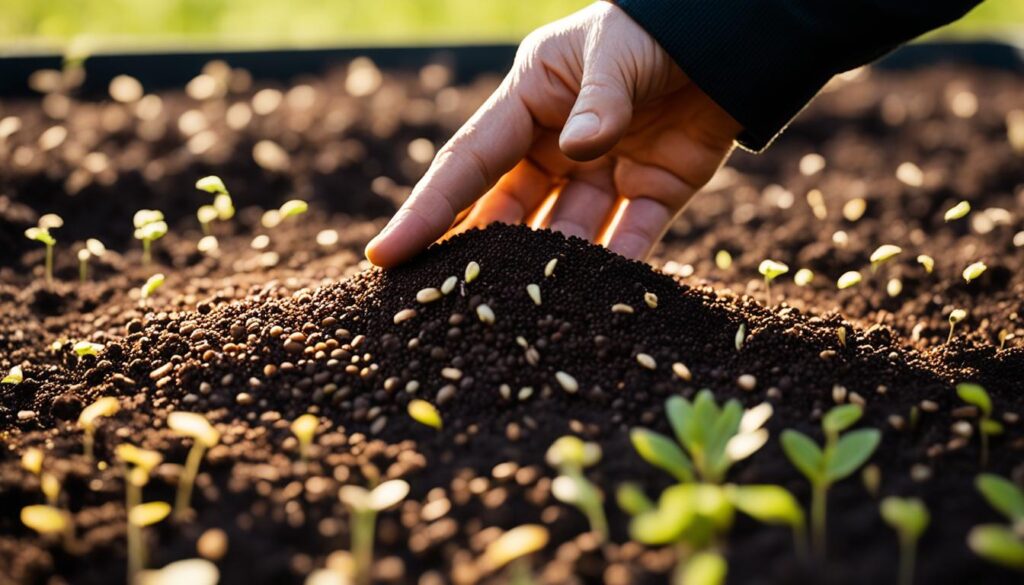
Continue reading to discover essential watering and care techniques to ensure the healthy growth of your flowers.
Watering and Care
Proper watering and care are crucial for the successful growth of your flowers. As a gardener, you need to ensure that your flower seeds receive the right amount of water and attention to thrive. Here are some tips and techniques to help you with flower care:
1. Watering Techniques
One of the best watering techniques for flowers is bottom watering. This method ensures that the water reaches the roots directly, encouraging healthy growth. To bottom water your flower seeds, simply place the containers in a tray filled with water, allowing them to soak up the moisture through the drainage holes. This prevents overwatering and keeps the soil consistently moist.
2. Moisture Management
It’s essential to keep the soil evenly moist without overwatering your flower seeds. Wet soil can lead to root rot and other water-related issues. To maintain the ideal moisture levels, check the soil regularly by inserting your finger about an inch deep. If it feels dry, it’s time to water. If it feels moist, refrain from watering to avoid waterlogging.
3. Temperature and Light
Monitoring the temperature and providing adequate light are also vital for the well-being of your seedlings. Ensure that your flower seeds are kept in a warm environment, ideally between 70-75°F (21-24°C). Additionally, place your containers in an area that receives sufficient sunlight. Most flowers require at least 6-8 hours of direct sunlight daily to grow and bloom optimally.
4. Fertilization
While proper watering is crucial, don’t forget about the importance of fertilization. As your flower seeds grow, they will require additional nutrients to thrive. Consider using a high-quality flower fertilizer or compost to provide your plants with the necessary nourishment. Adhere to the instructions on the fertilizer package for the correct application method and frequency.
To summarize, watering and care are essential aspects of successful flower gardening. By implementing proper watering techniques, managing moisture levels, monitoring temperature and light, and providing adequate fertilization, you can ensure the healthy growth and vibrant blooms of your flower seeds.
| Watering Tips | Care Techniques |
|---|---|
| Bottom watering | Monitoring temperature |
| Moisture management | Providing adequate light |
| Fertilization |
Troubleshooting Common Problems
Sometimes, despite our best efforts, problems may arise when growing flowers from seeds. Fortunately, there are solutions to common issues such as poor germination, slow growth, and disease. By addressing these problems promptly, we can ensure the health and vitality of our plants. Here are some troubleshooting tips to help you navigate through common flower care challenges:
Poor Germination
One common issue gardeners face is poor germination, where seeds fail to sprout or only a few seeds successfully germinate. Here are a few possible reasons and solutions:
- Inadequate moisture: Seeds need consistent moisture to germinate. Ensure that the soil is moist but not waterlogged. Consider using a spray bottle to mist the soil gently.
- Incorrect temperature: Different flower seeds require specific temperatures for germination. Refer to the seed packet or our gardening guide for recommended temperature ranges. Provide the ideal conditions by using a seedling heat mat or adjusting the room temperature as needed.
- Old or low-quality seeds: Seeds lose viability over time. Check the expiration date on the seed packet and consider purchasing fresh, high-quality seeds from reputable sources.
Slow Growth
If your flower seedlings are growing at a slower pace than expected, here are a few possible reasons and solutions to encourage healthy growth:
- Inadequate sunlight: Insufficient light can lead to leggy, weak seedlings. Ensure your seedlings receive 12-16 hours of light per day. If natural sunlight is limited, consider using a grow light to supplement the light requirements.
- Overcrowding: Seedlings need space to grow and develop a robust root system. Thin out overcrowded seedlings to allow adequate airflow and prevent competition for nutrients.
- Nutrient deficiency: Lack of essential nutrients can inhibit growth. Consider feeding your seedlings with a balanced fertilizer formulated for plant starts.
Disease
Flower seedlings are susceptible to diseases such as damping-off, powdery mildew, and fungal infections. Here’s what you can do to prevent and manage common diseases:
- Cleanliness: Start with clean containers, tools, and fresh soil to minimize the risk of disease. Regularly remove any fallen leaves or plant debris from the growing area.
- Air circulation: Good airflow helps prevent conditions favorable for disease development. Avoid overcrowding the seedlings and provide adequate spacing between plants.
- Fungicides: In severe cases, you may need to use a fungicide specifically labeled for the identified disease. Follow the instructions carefully and apply as directed.
Remember, proper flower care and gardening techniques are essential for preventing and overcoming common problems. By being proactive and addressing issues promptly, you can promote the overall health and success of your flower garden.
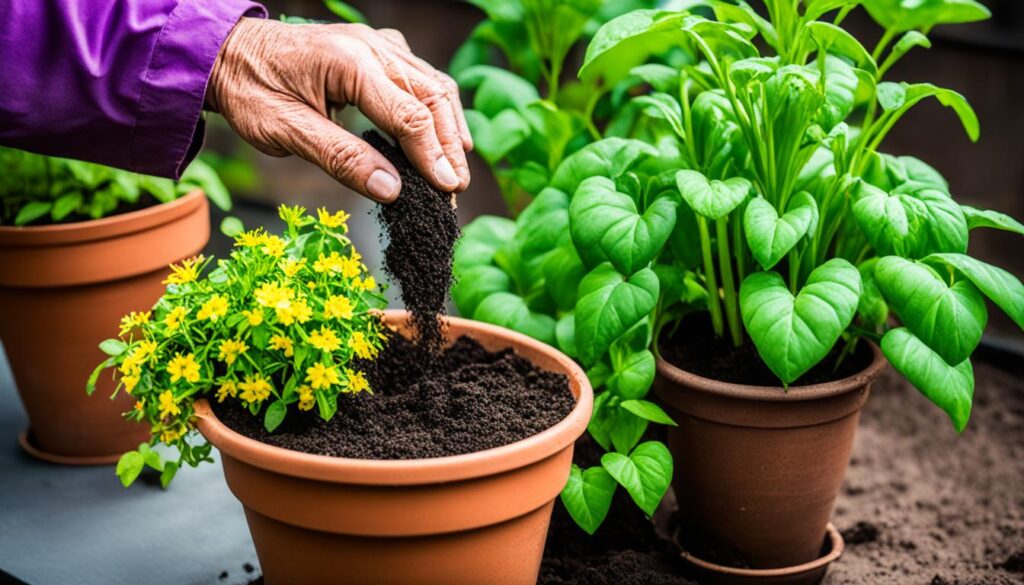
| Problem | Solution |
|---|---|
| Poor Germination | Provide adequate moisture, maintain the correct temperature, and use fresh, high-quality seeds. |
| Slow Growth | Ensure sufficient sunlight, thin out overcrowded seedlings, and fertilize with a balanced plant start fertilizer. |
| Disease | Maintain cleanliness, promote air circulation, and use appropriate fungicides when necessary. |
Providing Optimal Growing Conditions
In addition to proper watering and care, providing optimal growing conditions is crucial for the successful growth of your flowers. Creating the ideal environment for your plants will ensure healthy and vibrant blooms. Consider the following factors when cultivating your flower garden:
- Sunlight: Different flowers have varying sunlight requirements, so it’s essential to know the sunlight needs of the specific flowers you’re growing. Some flowers thrive in full sun, while others prefer partial shade. Be sure to place your flower beds or containers in a location that receives the appropriate amount of sunlight for your chosen blooms.
- Temperature: Flower seeds have temperature preferences for optimal growth. While some flower varieties can tolerate cooler temperatures, others require warmer climates. It’s important to understand the temperature requirements of your flowers and choose suitable planting times accordingly.
- Soil Fertility: Providing nutrient-rich soil is essential for the healthy growth of your flowers. Conduct a soil test to determine the pH level and nutrient content of your soil. If necessary, amend the soil with organic matter or fertilizer to optimize its fertility.
To further enhance the growing conditions for your flowers, consider using high-quality fertilizers that provide the necessary nutrients for optimal plant growth. Consult the guide for specific recommendations on fertilizers and their application methods.
Creating a favorable environment for your flowers will promote stronger roots, lush foliage, and abundant blooms. With proper care and attention, your garden will flourish with vibrant colors and fragrant scents.
The Joy of Growing Your Own Flowers
Growing your own flowers can be an incredibly rewarding experience. It allows you to immerse yourself in the beauty of nature and witness the miraculous transformation from seed to bloom. Whether you have a sprawling garden or a cozy balcony, flower gardening brings a sense of joy and fulfillment that is truly unmatched.
One of the greatest advantages of flower gardening is the wide variety of flowers you can choose from. From vibrant roses to delicate lilies, there are endless options to suit your personal preferences and style. You have the freedom to curate your own oasis of color and fragrance, creating a space that reflects your unique taste and personality.
Imagine waking up every morning to the delightful sight of blooming flowers right outside your doorstep. The vibrant hues and captivating scents infuse your surroundings with a sense of tranquility and happiness. Not only do flowers enhance the aesthetics of your garden, but they also attract butterflies, bees, and other pollinators, creating a harmonious ecosystem right in your backyard.
When you grow your own flowers, you have the opportunity to nurture and care for these delicate beings, watching them thrive under your guidance. It teaches you patience, responsibility, and a deep appreciation for the wonders of nature. As you witness the transformation from tiny seeds to beautiful blossoms, you develop a sense of pride and accomplishment that is truly fulfilling.
“Flowers are the music of the ground. From earth’s lips spoken without sound.” – Edwin Curran
Moreover, flower gardening provides a therapeutic escape from the stresses of daily life. Tending to your garden allows you to disconnect from technology and immerse yourself in the simple pleasures of nature. It is a form of meditation that brings peace and serenity to your mind, body, and soul.
Whether you’re a seasoned gardener or just starting out, growing your own flowers is a journey filled with beauty, discovery, and joy. It is a testament to the resilience and beauty of nature, reminding us of the wonders that exist all around us.
So why not embark on this delightful adventure and experience the joy of growing your own flowers? Allow yourself to connect with nature, cultivate beauty, and create memories that will last a lifetime. Get your hands dirty, embrace the sun-kissed mornings, and let your garden be a sanctuary of serenity and delight.
Conclusion
Whether you have a green thumb or are new to gardening, “From Seed to Bloom: A Comprehensive Guide to Growing Flowers Successfully” is the ultimate resource for all your flower gardening needs. This guide has covered everything from choosing the right flower seeds to providing optimal growing conditions. With its detailed instructions, helpful tips, and troubleshooting advice, you’ll be equipped with the knowledge and skills to cultivate beautiful flowers in your garden.
By following the gardening tips and techniques outlined in this guide, you can confidently embark on your flower growing journey. From sowing seeds to proper care and maintenance, each step is vital for the successful growth of your flowers. You’ll learn how to select the right seeds, prepare the soil, and water your plants effectively, ensuring their health and vitality.
Experience the joy of growing your own flowers and witness the beauty and colors they bring to your outdoor space. Whether you want to add vibrant blooms to your garden or create stunning floral arrangements, this comprehensive guide will empower you to achieve your flower gardening goals. So, grab your gardening tools, unleash your creativity, and let the beauty of nature bloom in your very own flower garden with “From Seed to Bloom: A Comprehensive Guide to Growing Flowers Successfully.”
FAQ
How do I choose the right flower seeds for my garden?
Consider factors such as the size and habit of the flowers, as well as the time of year they will bloom. Refer to our guide for specific flower recommendations and tips on selecting the right seeds for your garden.
Should I start my flower seeds indoors or outdoors?
It depends on the type of flower. Starting seeds indoors gives you more control over the growing conditions and allows you to start the plants earlier in the season. However, some flowers are easy to grow from seed directly in the garden. Check our guide for detailed instructions on how to start seeds indoors or outdoors.
How do I prepare the soil for my flower seeds?
It’s important to use a good quality seed starting soil that is light and airy. Follow our guide for instructions on how to fill your containers with soil, creating an ideal environment for your seeds to thrive.
How do I sow my flower seeds?
Our guide provides step-by-step instructions on how to sow the seeds, including the recommended number of seeds per cell or container. It also offers tips on labeling your seeds to keep track of the different varieties you are growing.
What is the proper way to water and care for my flower seeds?
Proper watering techniques, such as bottom watering, are crucial for the successful growth of your flower seeds. Our guide offers guidelines on how to keep the soil evenly moist without overwatering. It also covers other aspects of care, such as monitoring the temperature and providing the right amount of light for your seedlings.
What should I do if problems arise when growing flowers from seeds?
Our guide includes troubleshooting tips for common issues such as poor germination, slow growth, and disease. It provides recommendations on how to address these problems and ensure the health and vitality of your plants.
How can I provide optimal growing conditions for my flowers?
Factors such as sunlight, temperature, and soil fertility are important for the successful growth of your flowers. Our guide offers tips on how to create the ideal environment for your plants to thrive. It also highlights the importance of using high-quality fertilizers to support healthy growth.
What are the benefits of growing your own flowers?
Growing your own flowers allows you to choose from a wide variety and enjoy their beauty in your garden. Our guide emphasizes the rewards of flower gardening and encourages readers to take pride in their successful flower growing endeavors.
Where can I find more information on growing flowers?
“From Seed to Bloom: A Comprehensive Guide to Growing Flowers Successfully” is your go-to resource for all things related to growing flowers. With detailed instructions, tips, and troubleshooting advice, this guide equips you with the knowledge and skills to cultivate beautiful flowers in your garden.
Source Links
- https://www.hachettespeakersbureau.com/titles/eileen-powell/the-gardeners-a-z-guide-to-growing-flowers-from-seed-to-bloom/9781580175173/
- https://rootedflowers.com/blogs/farm-journal/step-by-step-how-to-start-flower-seeds-indoors-for-a-beautiful-garden
- https://www.gardeners.com/how-to/growing-annual-flowers-from-seed/5663.html

